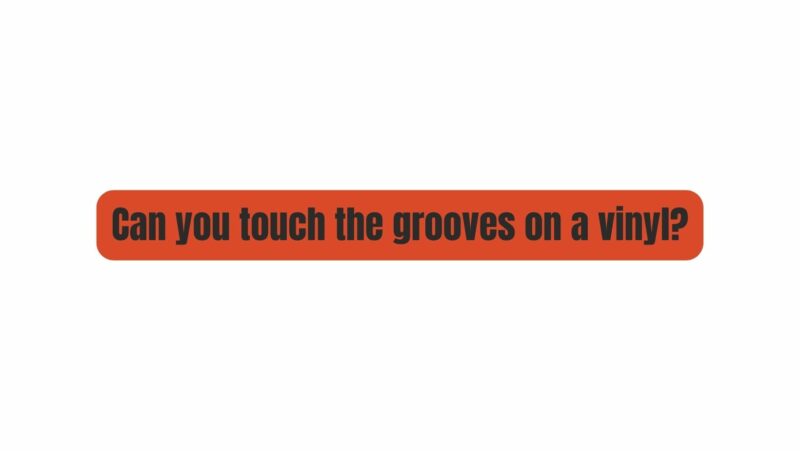Vinyl records, revered for their analog warmth and tactile appeal, have experienced a resurgence in popularity among audiophiles and music enthusiasts. One common question that arises in the vinyl community is whether it’s acceptable to touch the grooves on a vinyl record. In this article, we’ll explore the intricacies of vinyl record handling, the potential impact on sound quality, and the best practices for preserving your beloved vinyl collection.
The Fragile Beauty of Vinyl Grooves
Vinyl records are remarkable in their construction. They consist of a flat, circular disc with spiral grooves etched into the surface. These grooves are the physical representations of the recorded audio, with each groove modulation corresponding to specific musical frequencies. When a stylus (needle) runs along these grooves, it translates the physical grooves’ movements into sound.
Why Touching Grooves Is Discouraged
The grooves on a vinyl record are incredibly delicate, and touching them can have several negative consequences for both the record and the listening experience:
- Contamination: The natural oils, dirt, and debris on your fingers can transfer to the grooves, introducing contamination. These contaminants can degrade sound quality over time and may necessitate cleaning.
- Damage: Touching the grooves with your fingers can cause physical damage, including scratches, scuffs, and fingerprint marks. These blemishes can result in audible pops, clicks, and noise during playback.
- Static Electricity: Fingers can generate static electricity, which can attract dust particles to the record’s surface. This not only affects sound quality but also makes the record more challenging to clean.
- Warping: Holding a record by the edges minimizes the risk of warping, but touching the grooves can apply uneven pressure, increasing the likelihood of the record becoming warped over time.
Best Practices for Handling Vinyl Records
To ensure the longevity of your vinyl collection and maintain optimal sound quality, it’s essential to follow best practices for handling vinyl records. Here are the steps to handle vinyl records correctly:
- Wash Your Hands: Before touching any vinyl records, thoroughly wash and dry your hands. This helps eliminate contaminants that could transfer to the record.
- Hold by the Edges: When removing a record from its sleeve or jacket, always hold it by the edges. This minimizes contact with the grooves and reduces the risk of contamination and damage.
- Use a Dust Cover: When playing records on a turntable, ensure you have a dust cover in place to protect the vinyl from dust and foreign particles.
- Clean Your Stylus: Keep your stylus clean by using a stylus brush or cleaning solution regularly. A dirty stylus can also introduce noise and affect playback quality.
- Store Properly: When not in use, store your vinyl records in their protective sleeves and jackets. Store them vertically, like books on a shelf, to prevent warping.
- Invest in Anti-Static Solutions: Consider using anti-static brushes, mats, or cleaning solutions to reduce static electricity buildup and dust attraction.
- Avoid Direct Sunlight and Heat: Store your vinyl records in a cool, dry place away from direct sunlight and extreme temperature fluctuations.
What About Handling During Playback?
While it’s crucial to avoid touching the grooves during handling and storage, it’s common to wonder about handling when placing the record on a turntable or changing sides during playback. During these moments, some contact with the grooves is inevitable.
To minimize any potential harm, follow these tips:
- Handle the Record by the Label: When placing the record on the turntable or changing sides, hold it by the label in the center. This keeps your fingers away from the grooves.
- Use a Stylus Brush: Use a stylus brush before and after playback to remove any residual dust and particles that may have settled on the record’s surface.
- Clean the Turntable Platter: Regularly clean the turntable platter to prevent any contaminants from transferring to the record during playback.
- Use a High-Quality Stylus: Invest in a high-quality stylus that tracks the grooves accurately with minimal wear. A well-maintained stylus can help preserve both your records and your sound quality.
Conclusion: Cherishing Vinyl Records
In the world of music, vinyl records hold a unique and enduring place. Their grooves are not just physical representations of sound but also artifacts of history and artistry. To fully enjoy the rich analog experience they offer, it’s essential to treat vinyl records with the respect and care they deserve.
While it’s best to avoid touching the grooves whenever possible, it’s also vital to recognize that some contact during playback is inevitable. By following the best practices outlined in this article, you can minimize the risks of contamination, damage, and sound degradation.
Ultimately, the goal is to ensure that your vinyl collection remains in pristine condition, allowing you to relish the timeless sound and tangible beauty of vinyl records for generations to come. Cherish your vinyl, and it will reward you with countless hours of musical joy.


